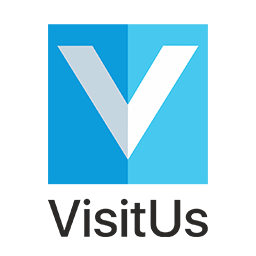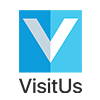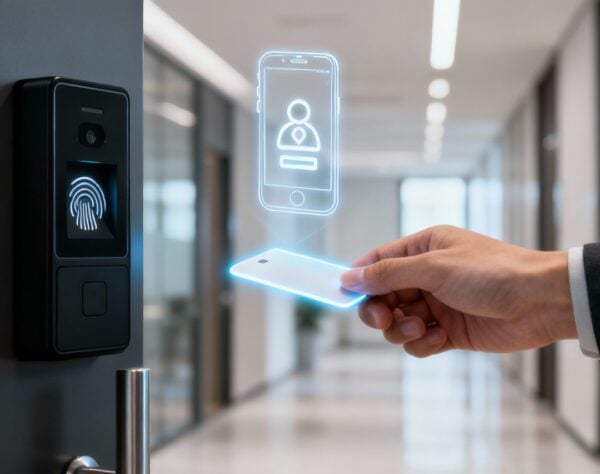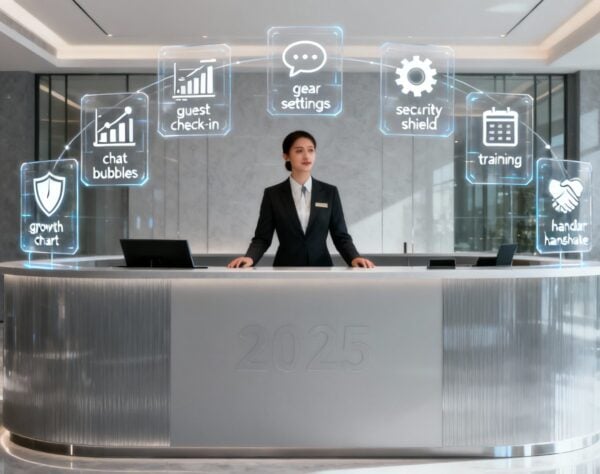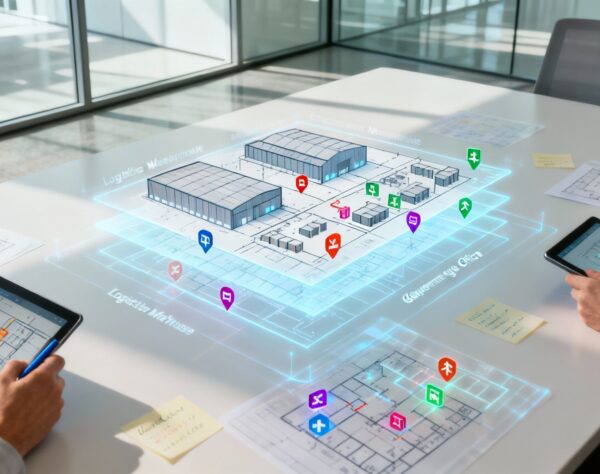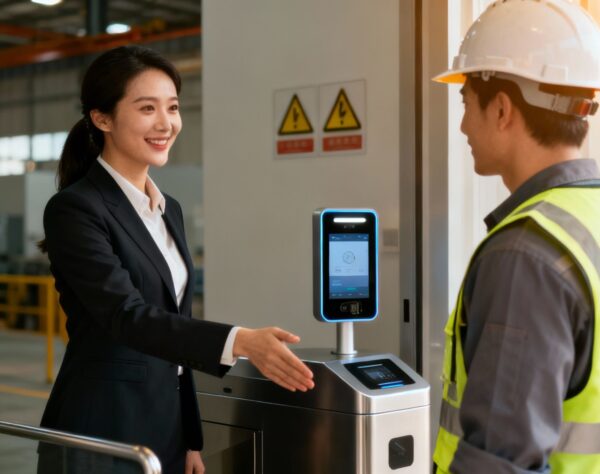
The Modern Visitor Management System Guide
Let’s be honest, that dog-eared paper logbook sitting on your reception desk is a liability. In today’s world, it’s a security risk. A simple clipboard leaves sensitive visitor details exposed, creating serious privacy issues and failing to provide any real-time insight into who is actually on-site.
In an emergency, this lack of information is chaotic. During a compliance audit, it’s a manual nightmare. A modern visitor management system is more than just a fancy replacement; it’s a strategic upgrade that transforms your reception into your first line of defense. It digitises how you manage everyone who walks through your doors—guests, contractors, and staff.
Moving Beyond the Paper Sign-In Sheet
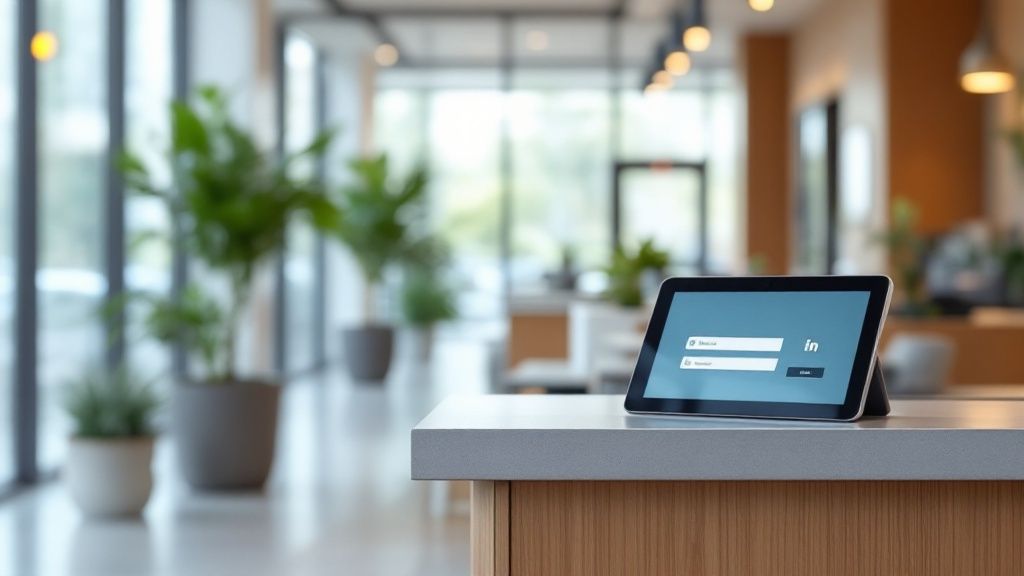
This isn’t just about looking modern; it’s about fundamentally rethinking workplace safety and operational efficiency.
A Strategic Shift in Workplace Safety
With hybrid work now the norm, knowing exactly who is in your building at any given moment is critical for security and emergency planning. A digital system provides this clarity instantly. It creates a secure, real-time log essential for everything from contact tracing to coordinating a safe evacuation, shifting visitor management from an admin chore to a core security function.
By digitising the check-in process, you create an unbreachable audit trail. Every entry is time-stamped and securely logged, providing verifiable proof of who was on-site—indispensable for compliance and incident investigation.
More Than Just a Digital Logbook
A visitor management system is one of the first interactions someone has with your brand. A clunky sign-in process suggests inefficiency, while a seamless digital experience communicates professionalism and a serious commitment to security.
The benefits ripple through the entire business:
- Enhanced Professional Image: A sleek, branded check-in kiosk immediately signals that your organisation is modern, secure, and values your visitors' time.
- Strengthened Security Posture: Screen visitors against watchlists and ensure only authorised personnel gain access, proactively stopping potential threats.
- Automated Compliance: The system automates crucial but tedious tasks like NDA signatures and safety inductions, ensuring you meet regulations effortlessly.
The global market reflects this growing need. Valued at USD 1.7 billion in 2024, the visitor management system market is projected to grow to USD 4.1 billion by 2029, driven by rising security concerns and data privacy regulations. You can read the full research about visitor management system market trends to learn more. This isn't a fleeting trend; it’s the new standard for a secure and efficient workplace.
Unlocking Your Core Business Benefits
A modern visitor management system delivers tangible benefits that directly improve your operations, security, and bottom line. Instead of focusing on technical features, let's look at the core results you can expect.
Fortify Your Security Perimeter
Your front door is your first line of defense. A visitor management system strengthens it by shifting from passive record-keeping to active security screening. It provides a crystal-clear, real-time picture of who is on your premises at all times.
This digital oversight is non-negotiable. Research shows that workplaces with weak physical security are up to 4.5 times more likely to experience theft or vandalism. By creating a verifiable digital audit trail for every visitor, you eliminate the anonymity that paper logbooks provide.
The security benefits are immediate:
- Digital Audit Trails: Every check-in is time-stamped, creating a rock-solid record for compliance audits or incident investigations.
- Watchlist Screening: Systems can automatically screen visitors against internal or external watchlists, flagging potential risks before they enter.
- Emergency Preparedness: In an emergency, you get an accurate, real-time list of everyone on-site, which is critical for ensuring everyone is accounted for and safe.
Drive Significant Operational Efficiency
Manual visitor processing is a major time drain for administrative staff. Constant interruptions to greet guests and track down hosts pull them from more critical work. In fact, studies indicate receptionists can spend up to 30% of their day just managing the visitor check-in process.
A visitor management system automates these repetitive tasks, freeing up valuable time. Visitors can pre-register and receive a QR code for a check-in that takes seconds. Upon arrival, the system instantly notifies their host via SMS, email, or platforms like Microsoft Teams. No more running around the office.
Automating the check-in process doesn't just save time; it crafts a seamless and professional first impression. It tells your visitors that you value their time and that you're an organised, modern company.
The infographic below shows how these core benefits work together to create an efficient, smooth experience.
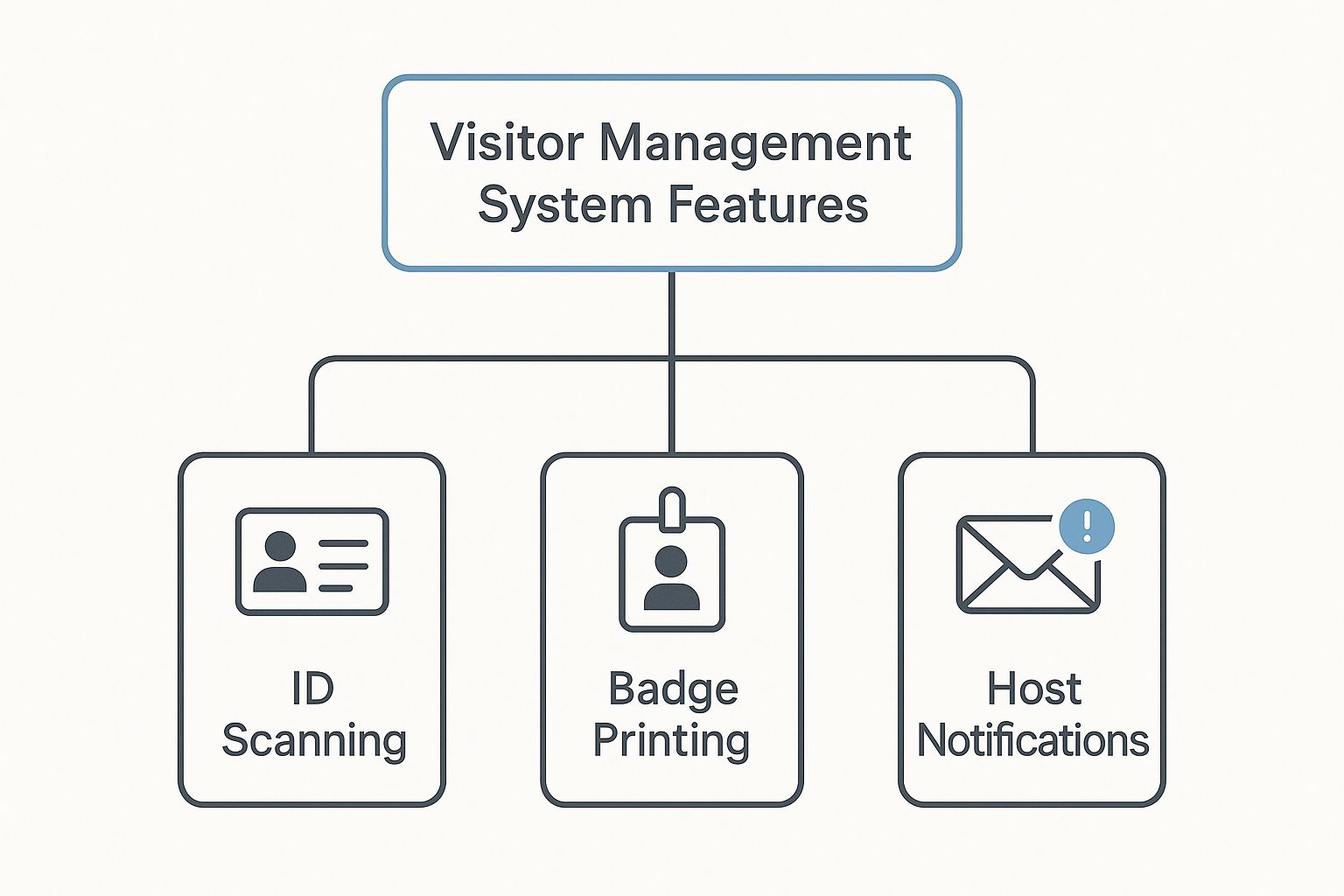
As you can see, automated features work in concert to support a secure and superior visitor experience.
Automate and Simplify Compliance
Meeting compliance obligations for data privacy and workplace safety can be a heavy administrative burden. A visitor management system transforms this manual, error-prone task into a streamlined, automated, and fully auditable process.
A paper logbook, where anyone can see the personal details of previous visitors, is a glaring compliance risk under regulations like Australia's Privacy Act. A digital system secures that data, restricts access, and ensures information is stored correctly, helping companies avoid hefty fines associated with data breaches.
This automation also covers other crucial areas:
- NDA and Policy Sign-offs: Require visitors to read and digitally sign NDAs or safety policies during check-in.
- Safety Inductions: Ensure contractors complete necessary safety briefings before entering work areas.
- Data Retention: Set automated policies to purge visitor data after a set period, aligning with privacy principles.
By building these steps into the check-in workflow, you guarantee that crucial compliance tasks are never skipped.
To see the difference, let's compare the old way with the new.
Benefit Comparison: Traditional vs Modern Visitor Management
This table highlights the clear advantages of a digital visitor management system over traditional paper-based methods.
| Business Area | Traditional Paper Logbook | Modern Visitor Management System |
|---|---|---|
| Security | Minimal security, easily forged, no real-time data | Real-time tracking, watchlist screening, photo capture, digital audit trail |
| Efficiency | Manual, time-consuming, prone to errors, interrupts staff | Automated check-in, pre-registration, instant host notifications, minimal staff effort |
| Compliance | High risk, visitor data is public, difficult to audit, manual record keeping | Secure data storage, automated policy sign-offs, easy audit trails, GDPR/Privacy Act friendly |
| Visitor Experience | Slow, impersonal, often creates queues and a poor first impression | Fast, professional, seamless, personalised welcome, quick and easy |
| Emergency Response | Inaccurate, unreliable, impossible to get a real-time list of people on-site | Instant, accurate evacuation lists accessible from anywhere, improved safety |
The takeaway is clear: moving to a modern system is a fundamental shift in how you manage safety, efficiency, and compliance.
If you're keen to dig deeper, you can discover more about the benefits of a visitor management system in our detailed article. It’s about creating a fundamentally safer and more secure environment.
How Different Industries Gain a Competitive Edge
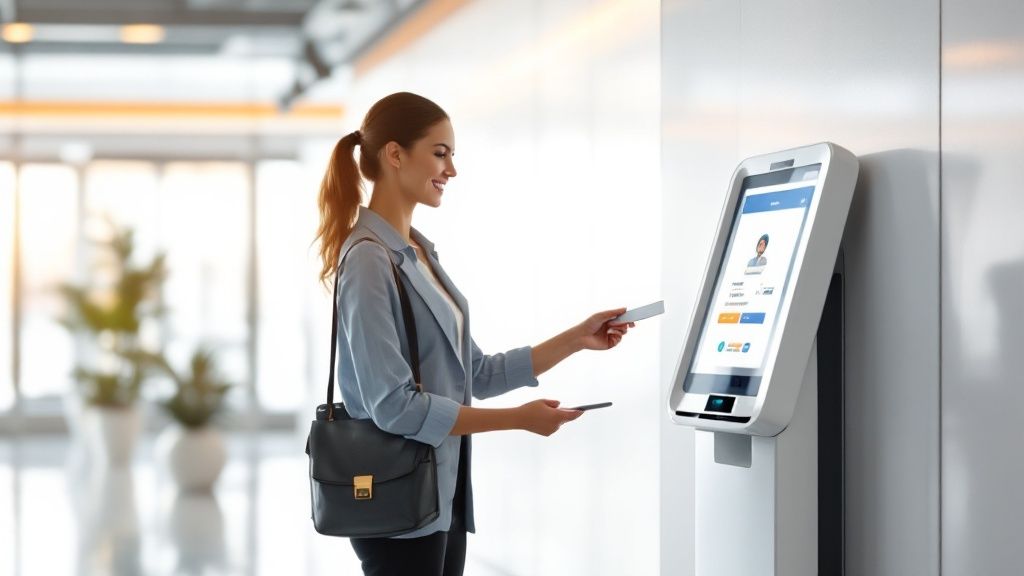
A visitor management system isn't a one-size-fits-all solution. Its real power is unlocked when it’s tailored to solve the unique challenges of a specific industry. Better security and smoother workflows are universal goals, but their application varies greatly from a corporate tower to a manufacturing plant.
This flexibility gives businesses a real advantage. The same core technology can protect patient privacy in a hospital or ensure every contractor on a construction site is properly certified. Let's look at how these systems benefit different sectors.
Corporate Offices in the Hybrid Work Era
With hybrid work, corporate offices face a constant flow of employees, clients, and interviewees, making it difficult to know who is on-site at any given moment. A visitor management system brings order to this dynamic environment.
The key benefit is creating a polished, professional first impression while maintaining building security. Pre-registration allows guests to receive a QR code for a quick scan upon arrival, which prints a pass and automatically notifies the host.
The big focus here is on efficiency and brand image. A slick check-in process makes your business look modern and on the ball. In fact, a positive first impression can boost client confidence by as much as 30%.
These systems also provide a live-updated list of every person on-site, which is critical for emergency evacuations and ensuring everyone is accounted for.
Manufacturing and Industrial Sites
On a manufacturing floor, the priorities shift from brand image to safety and compliance. The lobby is filled with contractors and delivery drivers, each presenting potential risks. The primary benefit is ensuring every person entering a hazardous area is properly briefed and meets Occupational Health and Safety (OH&S) requirements.
A visitor management system automates this critical process by providing:
- Mandatory Safety Inductions: Contractors can watch safety videos and pass a quiz on the check-in kiosk before a pass is printed.
- Compliance Verification: The system can block anyone with expired credentials by checking for valid trade certificates or work permits.
- Site-Specific Rules: Visitors must acknowledge site-specific hazards, creating a digital record of their agreement.
This benefit turns the check-in desk into the first line of defense in risk management. Businesses in this sector report that automating safety briefings can reduce induction-related admin time by over 50%.
Healthcare and Aged Care Facilities
In healthcare environments, patient privacy and infection control are top priorities. The key benefit of a visitor management system is providing the tight access control needed to protect vulnerable people and their sensitive information. The old paper sign-in book is a privacy breach waiting to happen.
A digital system secures that data, helping facilities comply with health privacy laws. It also helps manage visitor flow and screen for health risks by enabling:
- Health Screening: Check-in can include mandatory health declaration forms to screen for symptoms before entry.
- Access Control: The system can limit visitor numbers per resident and ensure only approved individuals can enter.
- Contact Tracing: In case of an outbreak, the system provides an instant, accurate log of every person on-site for fast and effective tracing.
This controlled environment demonstrates a commitment to the highest standards of care.
Education and School Campuses
For any school, nothing is more important than student safety. A visitor management system is one of the most effective tools for safeguarding a campus.
The system's benefit lies in its ability to instantly check every visitor against a school's list of approved guardians and even screen names against external watchlists. This provides a layer of protection that manual checks cannot match. It can track authorised pickups to ensure a child only leaves with the correct adult. To see how this works, you can find out more about a visitor management system for schools and its role in campus security.
By creating a complete log of every person on school grounds, schools dramatically improve security and provide peace of mind to parents and staff.
The Power of Cloud Platforms and Integrations
Modern visitor management lives in the cloud for good reason. Shifting to cloud-based platforms is a game-changer, offering flexibility and centralised control without the headache of maintaining physical servers.
The biggest benefit is centralised control. Imagine managing visitor access and security protocols for multiple offices from a single dashboard. This consistent, secure experience is why cloud systems accounted for over 60% of market revenue in 2024, with the market growing at about 16.5% annually. This growth is fuelled by the need for real-time control and automatic updates. You can discover more insights about these VMS market trends and what they mean for businesses.
Gaining Flexibility and Scalability
A key benefit of a cloud platform is its flexibility. As your business grows, adding a new office is simple. You avoid complex IT projects and expensive hardware. This agility lets you scale your security protocols alongside your growth.
Furthermore, cloud systems are always up-to-date with the latest software and security patches, as the provider handles all maintenance.
A cloud-based platform removes the limitations of a physical location. It transforms your visitor management from a site-specific task into a unified, company-wide security function that can be monitored and managed from anywhere, at any time.
Creating a Connected Workplace with Integrations
While a cloud-based VMS is powerful on its own, its true benefit is realised through integrations with other business tools. Integrations turn your VMS into the smart hub of a connected workplace, automating tasks and reducing human error.
Some of the most valuable integrations include:
- Access Control Systems: Automatically grant temporary access to specific doors when an approved contractor signs in, and deactivate it upon sign-out.
- Employee Directories: Syncing with tools like Azure Active Directory keeps host lists accurate, making notifications foolproof.
- Communication Platforms: Send instant arrival alerts to hosts via SMS, email, or collaboration tools like Microsoft Teams.
- Calendar Applications: Allow staff to pre-register guests directly from their Outlook or Google Calendar invites.
This connectivity builds a smarter, more responsive environment. To see how this could benefit you, explore our guide on a cloud-based visitor management system.
Choosing the Right System for Your Business
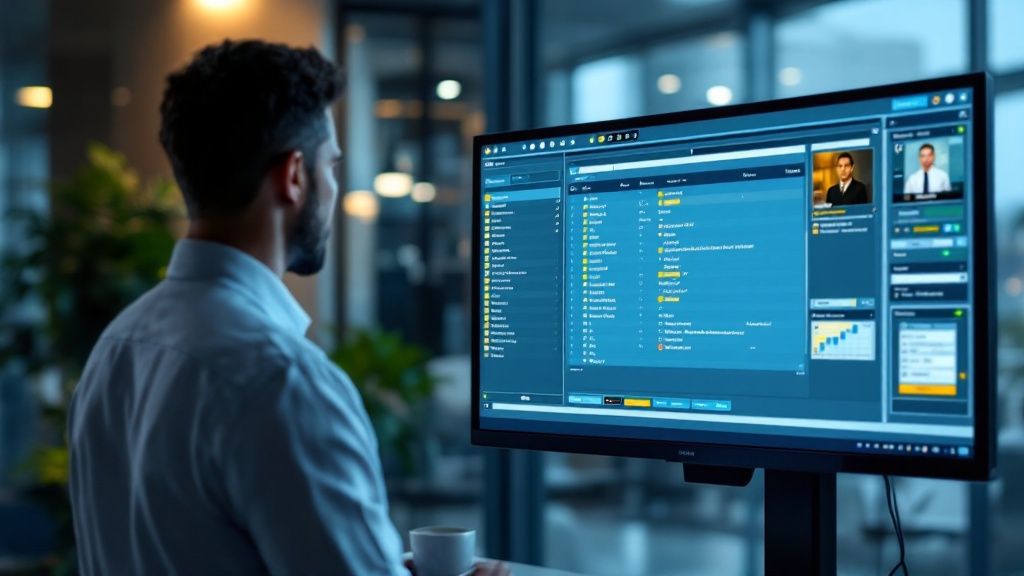
Picking a visitor management system is about finding a solution that solves your specific problems. The "best" system isn't the one with the most features; it's the one that aligns with your operational needs. A busy manufacturing plant has different priorities than a corporate head office.
You need to look past the sales pitch and match the system’s capabilities to your real-world challenges. Invest in a solution that makes life easier, not one that creates new headaches.
Assess Your Genuine Security Requirements
First, what level of security do you really need? There's no point paying for Fort Knox-level features if they're unnecessary.
Consider these tiers:
- Basic Security: The primary benefit is replacing the insecure paper logbook with a clear digital audit trail and instant host notifications.
- Enhanced Security: The benefit here is more control, through features like photo capture, watchlist screening, and professional visitor badges.
- Advanced Security: For high-risk environments, the benefit is comprehensive security, including ID scanning, access control integrations, and mandatory legal sign-offs.
Defining your security needs at the outset will narrow your options and prevent over-investment.
Define the Ideal Visitor Experience
The check-in experience speaks volumes about your company. A smooth, professional process shows you are organised and respect your visitors' time.
A key benefit is pre-registration, which allows guests to sign in on their phone and receive a QR code for a check-in that takes seconds. This is a game-changer for businesses with high visitor traffic, eliminating reception queues. A streamlined check-in also frees up front-desk staff. Automating visitor notifications can reclaim up to 30% of a receptionist's day, a significant efficiency gain.
Choosing a visitor management system is about crafting the perfect first impression. A seamless check-in tells your visitors you are organised, secure, and value their time, setting a positive tone for the entire interaction.
Plan for Scalability and Future Growth
The system you choose today must be able to grow with your business. A common mistake is selecting a solution that fits now but cannot expand.
This is where a cloud-based visitor management system provides a clear benefit. It allows you to manage multiple sites from a single dashboard, ensuring consistent security protocols. Adding a new location becomes as simple as setting up a kiosk, not a massive IT project.
For a deeper dive, our comprehensive visitor management checklist for 2025 offers a great framework for making a future-proof decision. It’s about choosing a partner that supports your journey.
Frequently Asked Questions
Switching to a modern visitor management system can bring up a few questions. Here, we tackle the most common ones to clarify the real-world benefits.
How Does a Visitor Management System Improve Data Privacy and Compliance?
The primary benefit is eliminating the serious privacy risk of a paper logbook, where visitor data is exposed. A digital system moves that sensitive information into a secure, encrypted database, helping you comply with regulations like Australia's Privacy Act.
Further benefits include automating compliance. You can set up automatic data retention policies to delete information after a set period. You can also build compliance into the check-in process by requiring visitors to digitally sign NDAs or privacy policies, creating a perfect, auditable record every time.
Can a Visitor Management System Integrate With Our Existing Security Systems?
Yes, and this is where you unlock its greatest benefit. Modern platforms are designed to integrate with other security and business tools, creating a connected security ecosystem.
The magic really happens when you create a connected security ecosystem. When your visitor system talks to your access control, a single check-in can set off a chain of automated actions—granting temporary door access, pinging the right people—all without anyone lifting a finger.
Leading systems offer integrations with:
- Access Control Systems: Granting visitors temporary, restricted access.
- Employee Directories: Connecting to Azure Active Directory for accurate host notifications.
- Calendar Applications: Allowing staff to pre-register guests directly from an Outlook or Google Calendar invite.
Is a Visitor Management System Suitable for a Small Business?
Absolutely. A common misconception is that these systems are only for large corporations. With cloud-based subscription models, they are affordable and accessible for businesses of any size.
The benefits for small businesses are the same: a more professional first impression, enhanced security, and a real-time list of who's on-site in an emergency. Many providers offer tiered plans, so you can start with the essentials and add features as you grow.
What Is the Typical Implementation Process for a Visitor Management System?
For a cloud-based system, the setup is surprisingly quick and simple. The process is designed to get you running with minimal fuss.
Typically, you'll set up your account, customise the check-in flow with your branding, and upload your employee list for host notifications. The final step is setting up the hardware, often just an iPad in a kiosk stand. Most businesses are fully operational in just a few hours.
Ready to turn your reception area into a secure, slick, and professional welcome point? See how VisitUs can provide a scalable solution that fits your business perfectly. Explore our features and get started today!
